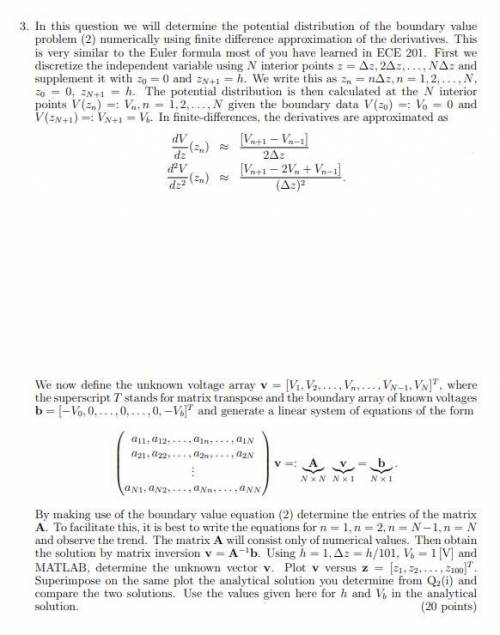
Engineering, 23.02.2022 15:10 chelsey54
In this question we will determine the potential distribution of the boundary value
problem (2) numerically using finite difference approximation of the derivatives. This
is very similar to the Euler formula most of you have learned in ECE 201. First we
discretize the independent variable using N interior points z = ∆z, 2∆z, . . . , N∆z and
supplement it with z0 = 0 and zN+1 = h. We write this as zn = n∆z, n = 1, 2, . . . , N,
z0 = 0, zN+1 = h. The potential distribution is then calculated at the N interior
points V (zn) =: Vn, n = 1, 2, . . . , N given the boundary data V (z0) =: V0 = 0 and
V (zN+1) =: VN+1 = Vb. In finite-differences, the derivatives are approximated as
dV
dz (zn) ≈
[Vn+1 − Vn−1]
2∆z
(3)
d
2V
dz2
(zn) ≈
[Vn+1 − 2Vn + Vn−1]
(∆z)
2
. (4)
We now define the unknown voltage array v = [V1, V2, . . . , Vn, . . . , VN−1, VN ]
T
, where
the superscript T stands for matrix transpose and the boundary array of known voltages
b = [−V0, 0, . . . , 0, . . . , 0, −Vb]
T and generate a linear system of equations of the form
a11, a12, . . . , a1n, . . . , a1N
a21, a22, . . . , a2n, . . . , a2N
.
.
.
aN1, aN2, . . . , aNn, . . . , aNN
v =:
|{z}
A
N × N
v
|{z}
N × 1
= b
|{z}
N × 1
. (5)
By making use of the boundary value equation (2) determine the entries of the matrix
A. To facilitate this, it is best to write the equations for n = 1, n = 2, n = N −1, n = N
and observe the trend. The matrix A will consist only of numerical values. Then obtain
the solution by matrix inversion v = A−1b. Using h = 1, ∆z = h/101, Vb = 1 [V] and
MATLAB, determine the unknown vector v. Plot v versus z = [z1, z2, . . . , z100]
T
.
Superimpose on the same plot the analytical solution you determine from Q2(i) and
compare the two solutions. Use the values given here for h and Vb in the analytical
solution.


Answers: 2


Another question on Engineering

Engineering, 04.07.2019 18:10
What difference(s) did you notice using a pneumatic circuit over hydraulic circuit.explain why the pneumatic piston stumbles when it hits an obstacle.
Answers: 2

Engineering, 04.07.2019 18:10
Aflywheel accelerates for 5 seconds at 2 rad/s2 from a speed of 20 rpm. determine the total number of revolutions of the flywheel during the period of its acceleration. a.5.65 b.8.43 c. 723 d.6.86
Answers: 2

Engineering, 04.07.2019 18:10
Different types of steels contain different elements that alter the characteristics of the steel. for each of the following elements, explain what the element does when alloyed with steel.
Answers: 2

Engineering, 04.07.2019 18:10
For the closed feedwater heater below, feedwater enters state 3 at a pressure of 2000 psia and temperature of 420 °f at a rate of ix10 ibhr. the feedwat extracted steam enters state 1 at a pressure of 1000 psia and enthalpy of 1500 btu/lbm. the extracted er leaves at an enthalpy of 528.7 btu/lbm steam leaves as a saturated liquid. (16) a) determine the mass flow rate of the extraction steam used to heat the feedwater (10) b) determine the terminal temperature difference of the closed feedwater heater
Answers: 3
You know the right answer?
In this question we will determine the potential distribution of the boundary value
problem (2) nu...
Questions






Mathematics, 14.10.2019 22:30


Social Studies, 14.10.2019 22:30


Computers and Technology, 14.10.2019 22:30



Computers and Technology, 14.10.2019 22:30









